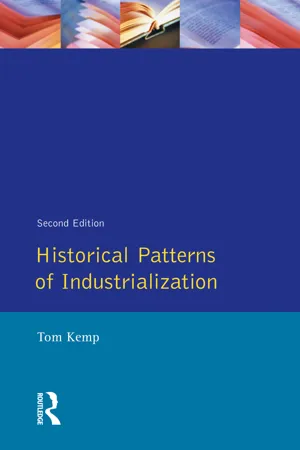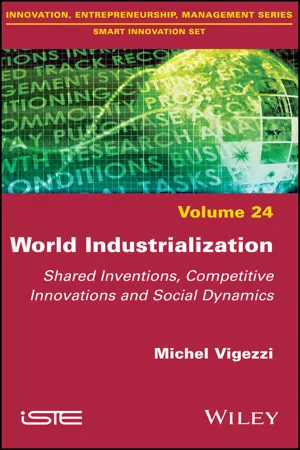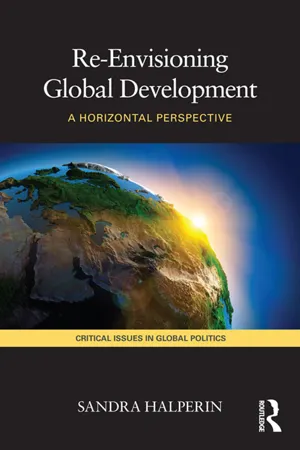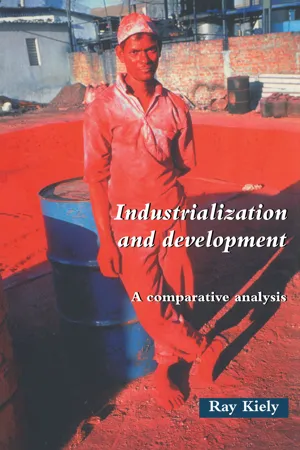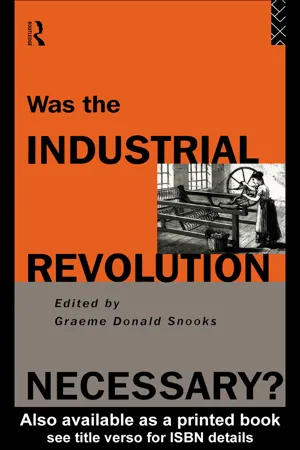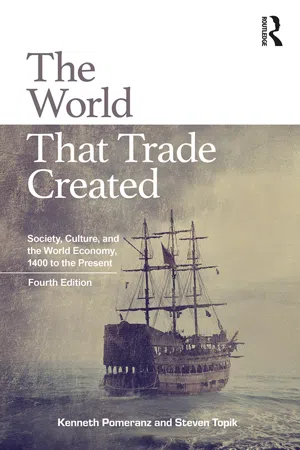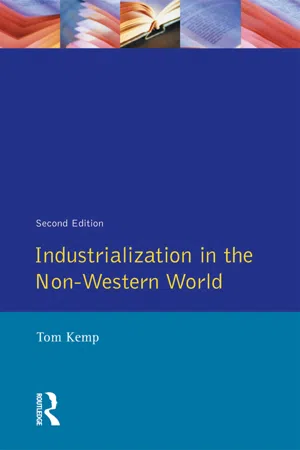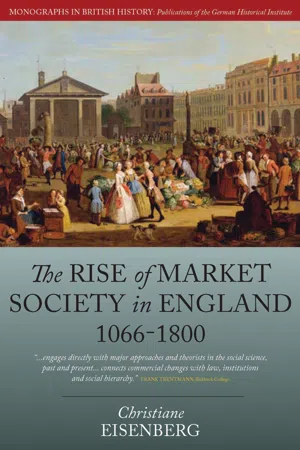History
Origins of Industrialization
The origins of industrialization refer to the period in history when societies transitioned from agrarian economies to industrial economies. This shift was marked by technological advancements, such as the development of machinery and the use of steam power, which transformed production processes. Industrialization led to urbanization, the rise of factories, and significant changes in social and economic structures.
Written by Perlego with AI-assistance
Related key terms
Related key terms
1 of 4
Related key terms
1 of 3
9 Key excerpts on "Origins of Industrialization"
- eBook - ePub
- Tom Kemp(Author)
- 2013(Publication Date)
- Routledge(Publisher)
Chapter Two Industrialization in historical perspectiveAbout 200 years ago, unbeknown to those living at the time, a fundamental revolution began in the history of mankind, which was to lead to the development of the world as we know it today. First in Britain, then in a few areas of Europe and North America, a structural transformation, seen in perspective as having been in preparation for centuries, shifted the balance of productive activity from agriculture to industry and opened up boundless possibilities for increasing the productivity of human labour. This process, best described as industrialization, brought into existence those forms of labour and styles of living distinguishing the modern world from the past, the advanced countries from the ‘backward’ ones.The central characteristic of industrialization is machine production, the basis for an enormous growth in productivity and thus for economic specialization in all directions. It created a new environment for work, with its own demands and laws – the factory. It brought about the concentration of workers in big industrial units and the growth of towns to house the working population, creating a new urban environment for social living. The new type of town, growing mushroom-like with industrialization, was not an adjunct to a predominantly agrarian society but a new dynamic force for change, the home of the majority of the population in a predominantly industrial society.Industrialization imposed new forms of the labour process by bringing together many workers under one roof to operate machines driven by power. Workers were incorporated into an articulated system of division of labour in which they performed only one small part of the total labour going into production. Characteristically, the new labour force was ‘free’ – not bound to the soil or to a single employer, but dependent wholly upon the market. The instruments of production were concentrated in the hands of a small class of industrial capitalists and represented a heavy outlay of capital upon which it was necessary to obtain a profitable return. A new form of industrial discipline had to be elaborated and imposed, one dependent not upon formal coercion but upon the worker’s need to earn a living and his fear of losing his job. Formally free, unlike the majority of producers in history before, the new industrial proletariat worked under the threat of economic deprivation. It was wholly dependent upon the labour market, or, what comes to the same thing, on the employers as a class. This new class division summed up the social relations of production of industrial capitalism; it was the source of conflicts and problems of the kind that still dominate modern society. - eBook - ePub
World Industrialization
Shared Inventions, Competitive Innovations, and Social Dynamics
- Michel Vigezzi(Author)
- 2019(Publication Date)
- Wiley-ISTE(Publisher)
Yet, since the end of the 17th Century, many other authors have tried to describe the emergence and development of global industrialization based on analyses that principally relate to several scientific fields ranging from economic history to technological and labor history. However, most of these authors have left ample room for other conceptual approaches such as the notions of “industrial revolution”, “technological change”, “machinism”, “inventions” or “innovations” without really clarifying the relationships between these approaches and industrialization. Although faced with difficult relationships between concepts whose definitions are not fully shared, other authors limit themselves to a priori representations of the notion of industrialization. 1.1.1.1. Initial representations of the notion of industrialization The imprecision of the definition of this notion led, initially, to the development of representations formulated a priori - eBook - ePub
Industrialization as an Agent of Social Change
A Critical Analysis
- Herbert Blumer(Author)
- 2018(Publication Date)
- Routledge(Publisher)
2. Industrialization as a Process of Technological Development
A second view of industrialization places emphasis on the formation over time of the technical innovations and improvements that attend the development of manufacturing. This view is likely to be found chiefly among economic historians who have been concerned with tracing the emergence and growth of the industrial or manufacturing system. Noting the appearance of the industrial revolution and tracing meticulously its formation and subsequent development, their attention is focused on the string of technological developments that made possible our modern manufacturing system. Thus, they trace the series of inventions and technological improvements in machines, the series of developments in metallurgy that made possible the creation of machines and metal equipment, the series of technological achievements in the development of chemicals needed in manufacturing, the achievements in creating and utilizing new forms of physical power to drive machines, and the technical developments in the organization of industrial resources. Such lines of technological development are responsible for the historical formation of manufacturing as a type of economic production. Since manufacturing is the heart of an industrialized system, these technological developments are regarded, in turn, as constituting the vital or central part of industrialization. Thus, one detects amid the divergent thinking of scholars a strong disposition to identify industrialization with the technological developments responsible for the introduction and growth of the manufacturing nucleus.This conception of industrialization is very unsatisfactory in seeking to treat industrialization as an agent of social change. As in the case of the first view of industrialization that we have just considered, this conception of industrialization provides no lines of contact with group life. It gives no handles that can be grasped in trying to tie industrialization, as a process, into ongoing group life. To note, for example, the introduction of a new type of machinery in the manufacture of textiles provides no bridge to the detection or understanding of the social changes that this technological improvement is supposed to bring about. As I have had occasion to note in the previous chapter, technological changes of an industrial character are of primary significance in terms of their effect on the industrial system. Their subsequent, or secondary, effects on group life have to be traced through the impact of the changed manufacturing system on such group life. The conception of industrialization we are considering is obviously deficient in its failure to indicate the lines of such impact. - eBook - ePub
Re-Envisioning Global Development
A Horizontal Perspective
- Sandra Halperin(Author)
- 2013(Publication Date)
- Routledge(Publisher)
3 Industrialization and the expansion of capital Core and periphery redefinedThe development of capitalism, according to most accounts, involved sweeping changes, first in agriculture and then, in its second and most vital stage, in industry. The previous chapter challenged conventional assumptions about the agricultural revolution which, it is generally thought, laid the basis for England’s industrial ‘take-off’. This chapter challenges widely held assumptions about the industrial revolution.We can begin with the term ‘industrial revolution’ itself. As historians have long argued, the use of the term ‘industrial revolution’ to describe the changes that took place in Europe during the latter half of the eighteenth century is misleading (Clark 1957: 652).1 The term suggests that there occurred at that time a revolution in technology that transformed the means of production. But there was no technological revolution, no transformation in means of production during the period of what we call the ‘industrial revolution’. Large-scale mechanized manufacturing had existed, in Europe as elsewhere, for at least a century (more likely several); and while Europe at that time saw an increase in the scale of industrial production, involving a massive mobilization of human and material resources and a reorganization of production processes, this revolution of scale, as it might be called, involved neither a revolution in technology nor a transformation either of means or relations of production.What, then, is meant by the term ‘industrial revolution’? The previous chapter ended by noting that, in the eighteenth century, powerful groups in Europe had launched a broad campaign to dismantle regulations tying production and investment to local economies. As this chapter will recount, by the end of that century, these efforts had succeeded in bringing about changes designed to ‘disembed’ local economies and accelerate the globalization of capital.2 Conventional historiography would lead us to assume that these developments, along with other changes at the time, were a result of the ‘industrial revolution’. But this chapter will argue that it was precisely these changes – the disembedding of local economies and the globalization of capital – that came to be called, misleadingly, the ‘industrial revolution’. Wherever industrial production expanded, whether of manufactured or agricultural or mineral goods, it was in order to increase exports. In Britain (‘the first industrial nation’), the capture of overseas markets through military means, and the successful struggle by aristocrats and wealthy merchants to free capital from state regulation, provided opportunities for these groups to profit from increasing overseas sales. It was only then - eBook - ePub
Industrialization and Development
An Introduction
- Ray Kiely(Author)
- 2023(Publication Date)
- Routledge(Publisher)
Part I Industrialization and development: definitions and debates
DOI: 10.4324/9781003419686-1Passage contains an image
Chapter One Introduction: defining industrialization and development
DOI: 10.4324/9781003419686-2This book addresses three principal questions: first, what is the relationship between industrialization and development?; second, who or what are the agents that promote industrialization?; and third, what is the relationship between late industrialization and the global economy? These questions are examined through a case study approach, which seeks to draw out the common features, and the contrasts between, various industrialization processes. The work can therefore be regarded as an attempt to construct a “post-impasse” historical sociology of development, as recommended by (among others) Nicos Mouzelis (1988) .1 A previous knowledge of the debates around the impasse in development sociology is not, however, a requirement for understanding the arguments in this book.Industrialization can be defined in three ways (Hewitt et al. 1992a : 3—6): first, as “the production of all material goods not grown directly on the land”, or second, as the economic sector comprising mining, manufacturing and energy. Most interesting for our purposes is the third definition, which sees industry as “a particular way of organizing production and assumes there is a constant process of technical and social change which continually increases society’s capacity to produce a wide range of goods” (Hewitt et al. 1992a : 6). In this definition, industrialization is regarded as a total process, impacting on society through an unprecedented increase in goods and services.For this reason, it is often assumed that there is a close link between industrialization and development. Development theory in the 1950s and 1960s often implicitly defined development as an increase in Gross National Product, and assumed that the increase in wealth associated with industrialization would trickle down to the bulk of the population. Writers such as Seers (cf. Chapter Two ) have questioned this view, without necessarily rejecting the idea that industrialization is necessary for development. Definitions of development now often include attention to basic needs such as decent health-care, education, income for all, and environmental sustainability. For instance, the Human Development Index (HDI) measures development according to life expectancy, educational attainment and real GDP per capita (UNDP 1995 : 12). More recently, a Gender-related Development Index (GDI) has been used to incorporate gender inequality into the measurement of HDI (UNDP 1995 : 73). Clearly then such measures question the view that industrialization and development are one and the same thing, although (as we shall see) they do not necessarily undermine the view that there is a close correlation between the two.2 - eBook - ePub
- Graeme Snooks(Author)
- 2012(Publication Date)
- Routledge(Publisher)
78 It is possible that in the very near future we will be facing a natural resources constraint as serious as that which prevailed throughout the later Middle Ages. If so it may take a change in technology and social organization as major and as unpredictable as that of the Industrial Revolution to prevent prolonged stagnation and instability.WHAT ARE THE IMPLICATIONS OF A FORWARD-LOOKING PERSPECTIVE?By placing the Industrial Revolution within the context of economic change during the last millennium we do gain a different perspective on this great event in human history. In the first place, it is suggested in this chapter that rapid and sustained rates of economic growth are not a modern invention. In terms of rates of economic growth, the Industrial Revolution was not a radical departure from what had been experienced in the periods 1000 to 1300 and, particularly, the sixteenth century. It has also been argued that growth over the last millennium has been a systematic process—a process of continuous transformation—rather than a series of random events. And this systematic growth process has proceeded via a succession of ‘great waves’ of economic change, of up to 300 years in duration.This wave-like growth process, which has involved a positive relationship between population and real GDP per capita, is driven by fundamental endogenous economic forces rather than by exogenously determined demographic forces. And a major actor in this process is economic man. But this endogenous process is subject to exogenous shocks in the form of pestilence and war, both civil and from foreign aggression. This view is to be contrasted with those that characterize longrun growth as being exogenously determined by an impact upon mortality and proceeding via inverse longrun swings in population and real GDP per capita. Growth, therefore, should be viewed not as a result of random events, but rather as a natural internally generated outcome of competitive societies.This continuous process of economic transformation was achieved in different ways in different periods. Longrun growth is not just a function of industrialization. For example, during the period 1000 to 1300, while there was a slow improvement in the technological foundations of agriculture, urban activities, and transport, the major part of this growth was due to the emergence of factor markets (particularly for labour and capital), and the widening of commodity markets, all of which reduced transactions costs.79 - eBook - ePub
The World That Trade Created
Society, Culture, and the World Economy, 1400 to the Present
- Kenneth Pomeranz, Steven Topik(Authors)
- 2017(Publication Date)
- Routledge(Publisher)
Almost 100 years ago, the historian J.H. Clapham was already calling the Industrial Revolution a “thrice squeezed orange”—a subject that had little juice left. He nonetheless wrote another book about it, touching off new debates. Today we still have little consensus on exactly how industrialization—the movement of most workers out of agriculture, fishing, and forestry into jobs where they used increasingly powerful mechanical devices to transform objects—occurred or what role trade played in that transformation. The effects of trade between already industrialized areas and those that are still primarily agrarian are even more controversial—in particular, under what circumstances did such trade make it easier or harder for the “less developed” trading partner to industrialize itself? Since virtually all prosperous economies today are industrial or post-industrial, this question is one version of a still more basic one: does participation in international trade really benefit all parties, or do inequalities of wealth and power cause some participants to lose out? The historical complexities of this question stem in part from the fact that very few countries have ever done in practice what elementary economic theory tells them is obviously good for them: namely, institute free trade with all other countries, regardless of relative levels of development. So somebody—maybe everybody—must be confused.World Trade and Early IndustrializationPeople have made things for millennia, so when does “industrialization” begin? Workshops that employed huge numbers of workers go back centuries, mostly in a variety of royal and imperial factories making weapons, uniforms, and certain luxury goods. Although most processes were powered by human and animal muscle (the very word “manufactured” once meant “made by hand”), waterpower, coal, and other mechanical and chemical power sources were not unknown: the salt works in China’s Sichuan Province even burned natural gas close to 2,000 years ago. But if one looks for the first place where large numbers of workers worked very intensely and in a coordinated way (as opposed to each working separately side by side under one roof), with the timing of tasks determined by the physical needs of a fuel-intensive production process yielding a standardized product, the prototype for modern factories might be found in an unsuspected place—the sugar mills of Latin America, where cane (which rots quickly if not processed) was crushed, boiled, and made ready for its transatlantic journey (see reading 7.1 , page 267). And in that case, not only did factories originate outside Europe, but the first laborers to adjust to factory life were not wage earners but slaves, and not Europeans but Africans.In Western Europe, by contrast, workers were not slaves, and could not be made to work longer and harder by coercion alone. Yet quite a lot of evidence suggests that many free people in parts of Western Europe, East Asia, and perhaps elsewhere were laboring more and more intensively—longer, harder, and with more concentration—during the last couple of centuries before the beginning of industrialization. These societies were, to that extent, preadapted to the industrial world, even though it would take a long time to reach many of them. - eBook - ePub
- Tom Kemp(Author)
- 2014(Publication Date)
- Routledge(Publisher)
The situation is obviously a complex one. Much of the industrialization which has been taking place in the non-Western world has not been a response to an expanding internal market. It has differed in fundamental respects (except in the case of Brazil) from the models examined in earlier chapters, whether undertaken in accordance with market forces or some form of planning. Controlled or stimulated by the great MNCs, this kind of industrialization in the ‘developing’ countries has not been the start of rounded and self-reliant economic development and social improvement. It has only brought higher living standards for a fortunate minority and, in general, has made no inroads into the secular stagnation of still predominantly agrarian and underdeveloped, dependent, countries. To explain how this has come about it is necessary to make a brief excursion into the historical origins of present-day underdevelopment.Origins of Underdevelopment
The industrialization first of Britain and then of the other advanced countries of Western Europe and North America in the nineteenth century would not have been possible without bringing into existence a world division of labour in which most other areas of the world were turned into sources of primary products. This was the case whether the countries concerned remained politically independent, became spheres of influence, or were turned into colonies. Their economies were shaped to the needs of the advanced industrial and consuming countries of the Western World. In that sense they remained underdeveloped as primary producers with little or no modern industry, low per capita incomes and little growth outside the primary-producing sector. Taking the world as a whole, manufacturing industry was concentrated in a few geographical zones, with only odd outposts scattered elsewhere. These industrial areas could call on the resources of the less developed and dependent areas for their supplies of raw materials and foodstuffs and in addition to this could export manufactured goods to them. The success of industrialization, once established, depended upon insertion into this pattern. At one time it seemed that Japan constituted the last great success story, but in recent decades other countries, especially in East Asia, have been trying to follow her example. On the other hand, as has been seen, neither India nor China were able to emulate Japan, a major reason for this being their political and economic dependence upon the Western imperialist countries. - eBook - ePub
- Christiane Eisenberg(Author)
- 2013(Publication Date)
- Berghahn Books(Publisher)
52The general scepticism with regard to the concept of proto-industrialization does not mean that British historians have not thoroughly studied the matter. However, they had different points of interest from their Continental European colleagues. While the latter kept their focus on the producers and the production process, the Britons more closely examined the sale and consumption of proto-industrially produced products.53 In particular, two connections emerged from these studies that are of particular interest in the framework of the history of commercialization.The first relates to the demand for proto-industrially produced goods. Here, more recent research has substantiated the thesis already posited in the 1970s and 1980s that in England in the course of the seventeenth and eighteenth centuries, a ‘consumer revolution’ took place that changed the lives not only of the aristocracy, the gentry and other wealthy people, but also of agricultural labourers, servants and workers.54 The increased demand had its origin in economic policy initiatives on the part of the Crown, and for this reason it already became apparent in the first half of the seventeenth century. It then increased after 1650 under the impact of a massive rise in income and the emergence of closely meshed credit relations in cities, villages and neighbourhoods, which also helped to compensate for the problem of the dearth of coins.55 Everyone now purchased provisions via the market, and the lower classes also acquired a great number of goods that they had never previously owned. These included sugar, tea and tobacco, as well as silk and cotton fabrics from North and South America, the Caribbean and the Far East; but also domestically produced textiles and other, largely proto-industrially manufactured products such as glass, housewares, furniture and haberdashery. The British manufacturers of these consumer goods drew inspiration for their designs in part from the foreign imports.56
Index pages curate the most relevant extracts from our library of academic textbooks. They’ve been created using an in-house natural language model (NLM), each adding context and meaning to key research topics.
Explore more topic indexes
Explore more topic indexes
1 of 6
Explore more topic indexes
1 of 4
